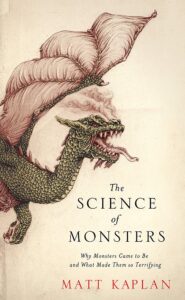 The Science of Monsters, Matt Kaplan
The Science of Monsters, Matt Kaplan
Part of the entertainment factor of this book is the fact that it takes its theories too far. After explaining Chimaera legends as the result of animals wandering into a tar pit and becoming fossilised in a weird tangle, the author goes on:
And Chimera was hardly alone. If a horse went down to a tar pit for a bit of water, got stuck, died, and was subsequently fed upon by a vulture that also got stuck in the tar, that would provide an explanation for the legendary Pegasus. Some art even shows Chimera battling with Pegasus. Was this linked to a find of fossils that people could barely make sense of?
He then goes on to use tar pits to explain sphinxes and Scylla: “Indeed, if there is a monster that stands as evidence that the ancients were looking at fossils of multiple animal skeletons jumbled together, it is Scylla.”
He does nobly admit right after that that “this requires tar pits, and Greece (and the rest of Europe) doesn’t have any”! Yes, that would be a bit of a problem for this theory, but it’s okay — he then posits trade routes as bringing the stories to Greece…
The problem with this book is that there is a lot of truth in it: it discusses gigantism in humans as arising due to tumours in the pituitary gland and suggests that could be the source of some monstrous legends; it points to fossils and tar pits as origins of various monstrous legends and ideas; it points out that giant predators were around in the past. However, it leans on these ifs and maybes — and on a good deal of special pleading — and takes it way too far. Maybe we imagined Cerberus because a giant slavering dog with three heads just seemed scary, you know? No need for three wolves to be swept off to sea together and fossilised as a jumble of bones with three heads.
In the end, I got tired of the exercise for my rolling eyes and put this down, relieved that I never paid for it and instead borrowed it. Whew. If you’re interested in some of the potential scientific seeds of monster stories, there are definitely nuggets of truth here. I learnt that the pituitary tumour thing actually ran in families due to a genetic disposition, producing families of giants! I learnt about some monsters I didn’t know that well! But… I have serious questions about the author’s seriousness here: his Chimera and Pegasus idea really begs for us to ask whether he thinks the fights between King Kong fighting Godzilla were inspired by film-makers finding an enormous ape fighting an enormous reptile in a tar pit? Or does he recognise that while the monstrous can (probably always does) grow from seeds of reality, probably a lot of ancient story-tellers were just thinking up ways to scare the shit out of each other, create amazing spectacles for artwork, or just tell a good story.

Leave a Reply